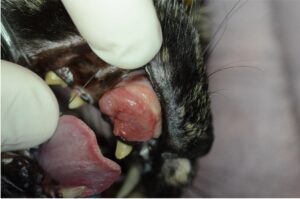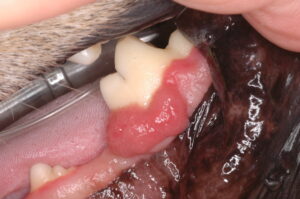
06 Jun Oral Tumors in Dogs and Cats: Risks and Management
Oral tumors in dogs and cats are relatively common, and they can pose significant health risks if left untreated. These tumors can arise from various tissues within the oral cavity, including the gums, tongue, lips, and jawbones. Understanding the risks associated with oral tumors and knowing how to manage them is crucial for pet owners. This article aims to provide a comprehensive overview of the risk factors associated with oral tumors in dogs and cats and the available management options.
Risk Factors
- Age: Older animals are generally at a higher risk of developing oral tumors.
- Breed Predisposition: Certain dog breeds, such as Boxers, Golden Retrievers, and Scottish Terriers, are more prone to oral tumors.
- Dental Health: Poor oral hygiene and untreated dental diseases can increase the risk of oral tumors.
- Tobacco Smoke Exposure: Cats living in households with smokers have an increased risk of developing oral squamous cell carcinoma.
- Feline Immunodeficiency Virus (FIV): Cats infected with FIV are more susceptible to developing oral tumors.


Types of Oral Tumors
- Squamous Cell Carcinoma: The most common oral tumor in cats, often affecting the gums, tongue, and tonsils. It is the second most common malignant tumor in dogs.

- Fibrosarcoma: More commonly seen in dogs, these tumors arise from the connective tissues and can affect the bone.
- Melanoma: Melanomas can occur in the oral cavity of dogs and cats and may be malignant. This the most common oral tumor in dogs and is extremely aggressive. They can spread early to the regional lymph nodes or to other parts of the body.
- Peripheral Odontogenic Fibroma (formerly called an ‘epulus’): This refers to a group of benign tumors that arise from the periodontal ligament. It is more commonly seen in dogs but it can occur infrequently in cats.
- Canine Acantomatous Ameloblastoma: This tumor originates from the tooth-supporting tissues and is more prevalent in dogs. This is a very aggressive benign tumor.

Management Options
- Early Detection: Regular oral examinations by a veterinarian are essential for early detection of any abnormalities or tumors.
- Biopsy: A definitive diagnosis can be made through a biopsy, which involves the removal of a small tissue sample for microscopic examination. DO NOT ALLOW ANYONE TO CUT A GROWTH OFF WITHOUT FIRST GETTNG A BIOPSY AS THE ARCHITECTURE OF THE SURROUNDING TISSUE WOULD BE ALTERED. We also take pictures of the growth so the pathologist can get a view of this as well as a veterinary dental specialist. This is essential.
- Imaging: Radiographs or advanced imaging techniques such as CT scans can help evaluate the extent of the tumor and plan surgical intervention.
- Surgery: Surgical removal is the primary treatment for oral tumors whenever possible. Depending on the tumor type and location, partial or complete resection may be performed.
- Radiation Therapy: In cases where complete surgical removal is not feasible, radiation therapy can be used as an adjunct treatment to reduce tumor size and control local spread.
- Chemotherapy: Chemotherapy may be recommended in certain cases to help manage metastatic disease or in tumors that are not amenable to surgical or radiation treatment.
- Palliative Care: In situations where the tumor cannot be treated curatively, palliative care focuses on maximizing the pet’s comfort and maintaining a good quality of life.
Conclusion
Oral tumors in dogs and cats can present significant health risks, and early detection and intervention are crucial for optimal outcomes. Pet owners should be vigilant in maintaining good oral hygiene and scheduling regular veterinary check-ups. If an oral tumor is detected, prompt evaluation, including biopsies and imaging, is essential for accurate diagnosis and appropriate treatment planning. With advancements in surgical techniques, radiation therapy, and chemotherapy, the management options for oral tumors have improved, offering hope for improved outcomes and quality of life for affected pets.
Barden Greenfield, DVM, DAVDC Angela Briggs, DVM, DAVDC Your Pet Dentist of Nashville
References:
- Marretta SM, Legendre AM, Farese JP. Oral tumors in dogs and cats. Vet Clin North Am Small Anim Pract. 2012;42(4):789-810. doi:10.1016/j.cvsm.2012.04.006
- Reetz J, Soltero-Rivera MM, Dernell WS. Oral and Maxillofacial Tumors in Dogs and Cats: A Comparative Review. Veterinary Sciences. 2016;3(3):14. doi:10.3390/vetsci3030014oral
- Verstraete FJM, Kass PH. Oral and Maxillofacial Tumors in Dogs and Cats. Part 1: Diagnosis. Vet J. 2009;179(3):270-279. doi:10.1016/j.tvjl.2007.08.023
- Reiter AM, Lewis JR, Lucroy MD. Feline Oral Squamous Cell Carcinoma: Clinical Manifestations and Literature Review. J Vet Dent. 2016;33(1):7-17. doi:10.1177/089875641603300103


